The Moon Covers the Maiden’s Eyes, Mars Meets its Rival, and a Missing Moon Flatters Taurus’ Treats!

Alan Dyer of Calgary captured this spectacular image of a comet named Wirtanen passing the Pleiades star cluster on December 15, 2018. His gallery of incredible images can be found here and at AmazingSky.com.
Hello, January Stargazers!
Here are your Astronomy Skylights for the week of January 12th, 2020 by Chris Vaughan. Feel free to pass this along to your friends and send me your comments, questions, and suggested topics. You can follow me on Twitter as @astrogeoguy! Unless otherwise noted, all times are Eastern Time. To subscribe to these emails please click this MailChimp link.
I can bring my Digital Starlab portable inflatable planetarium to your school or other daytime or evening event. Contact me through AstroGeo.ca, and we’ll tour the Universe together!
The waning and late-rising moon will give us darker evening skies the world over this week – fine for chasing the comet in Perseus and viewing the delights in Taurus and Orion. For many of us, the moon will briefly cover the eyes of Virgo on Tuesday. After sunset all week, lovely Venus will shine brightly in the western sky, and Mars will meet its rival Antares in the pre-dawn east. Here are your Skylights!
The Moon and Planets
After last Friday’s Full Wolf Moon and penumbral lunar eclipse, this week skywatchers around the world will see the moon wane in phase and rise later as it journeys through the third week of its monthly orbit of Earth. That will leave evening skies delightfully dark for evening stargazing.
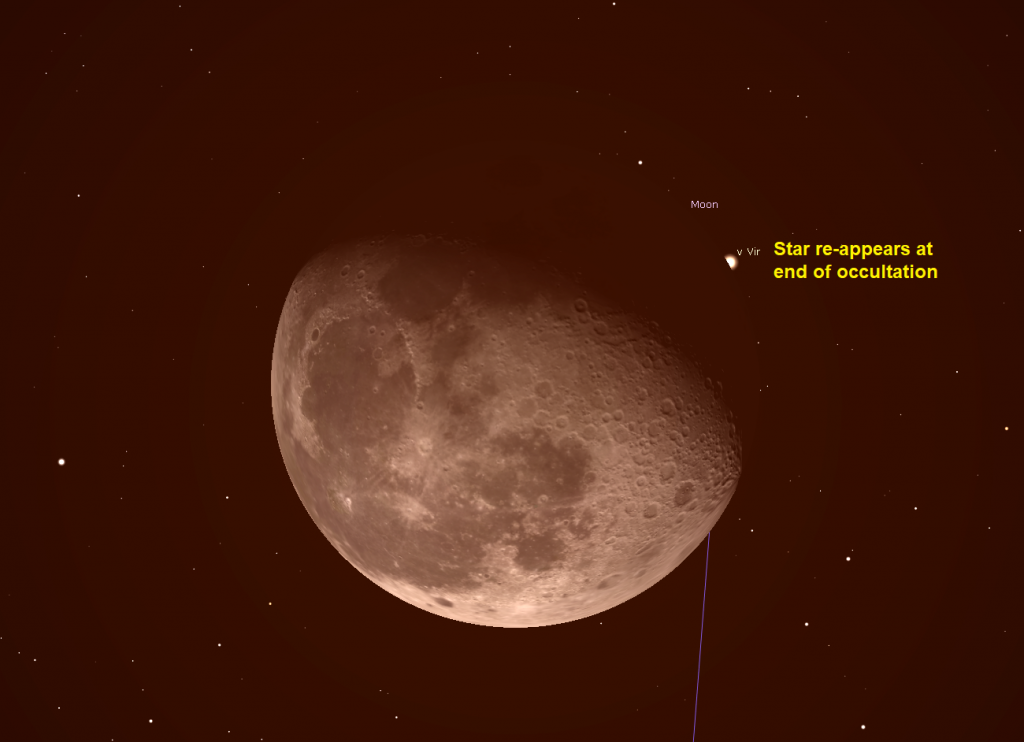
Tonight (Sunday) the still very bright and full-ish moon will rise in mid-evening and shine among the stars of Leo (the Lion). After spending one more night in Leo, the moon will pass into Virgo (the Maiden). Late on Tuesday evening, observers in parts of the world will see the moon cross in front of (or occult) a medium-bright star designated v Virginis, which marks the maiden’s head, or her eyes. At approximately 11:38 pm EST, the leading, bright edge of the moon will pass over the star. At 12:26 am EST, the star will suddenly re-appear from behind the dark, opposite edge of the moon. Exact timings will vary by location, so begin looking a few minutes earlier than the times above, which are for the GTA and Great Lakes area.
It’s fun to zoom in on the star in a telescope and watch the moon slide closer and then hide it. If you aren’t sure where on the moon’s dark edge the star will re-appear, use a magnification that shows the entire moon in your eyepiece, and remember that your telescope will flip things around. Observers located south of about 35° N latitude will only see the moon skim past the star.
From Wednesday to Friday, the waning moon will rise after midnight among the stars of the large constellation of Virgo. On Friday morning at 7:58 am EST (12:58 GMT), the moon will reach its last quarter phase worldwide – when it will make a 90 degree angle with the sun and appear with a half-illuminated disk. As with first quarter moons, last quarter moons are beautiful sights in binoculars and telescopes – because sunlight is arriving at a shallow angle and casting long, black shadows from every bump and ridge on the moon’s rugged surface.
For the balance of this week, the moon will become a pretty, slender crescent shining over the southeastern horizon before dawn. It will persist into the daytime morning sky, too.
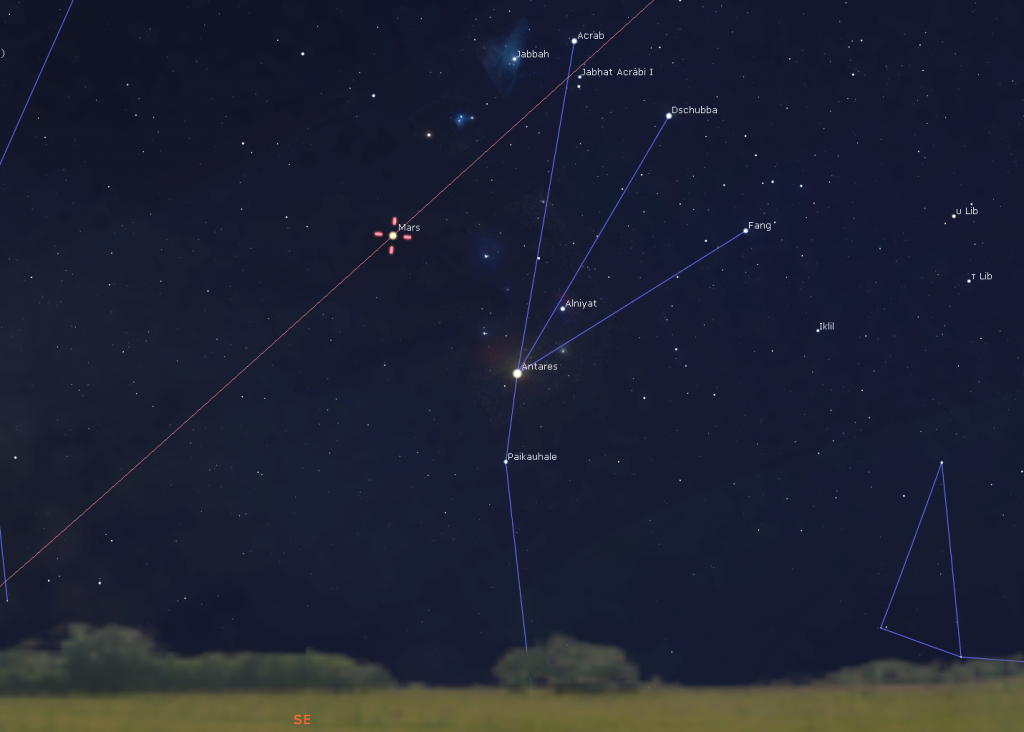
Speaking of the morning sky, Mars will shine in the southeastern sky before dawn sky this week – as it will for several more months to come. The red-tinted planet will rise at about 4:30 am local time and remain visible until dawn as a red-tinted, star-like object of medium brightness. (In a few months, Mars will become larger and brighter ahead of next autumn’s opposition.) The relative positions and combined orbital motions of Earth and Mars are causing Mars to appear in roughly the same place in the sky at the same times every morning. However, the planet is actually moving rapidly eastward across the distant background stars – because they rise four minutes earlier every morning, while Mars does not.
This week, Mars will sit to the lower left (or celestial east) of the three white claw stars of Scorpius (the Scorpion), and draw farther away from them every morning. At the same time, if you have a low, open southeastern horizon, look for Mars’ stellar rival, the bright, ruddy-tinted star Antares, sitting a palm’s width to the lower right of Mars. On Friday and Saturday morning, January 17-18, Mars will pass less than a palm’s width (or 5 degrees) to the north of Antares. The star will outshine Mars.
In the evening sky, our sister planet Venus will continue its lengthy winter appearance this week – shining extremely brightly in the southwestern sky among the stars of Aquarius (the Water-Bearer) and setting shortly after 8 pm local time, in a dark sky. Viewing Venus in your telescope during the coming weeks will reveal that its shape is less than fully round because the sun is shining on it from off to one side. Venus will continue to wane in phase as it swings wider from the sun between now and the end of April. Use your telescope on Venus while the planet is higher in the sky, and after the sun has completely set – from about 5:45 pm local time. That way, you’ll reduce the amount of distorting air you will be looking at Venus through.
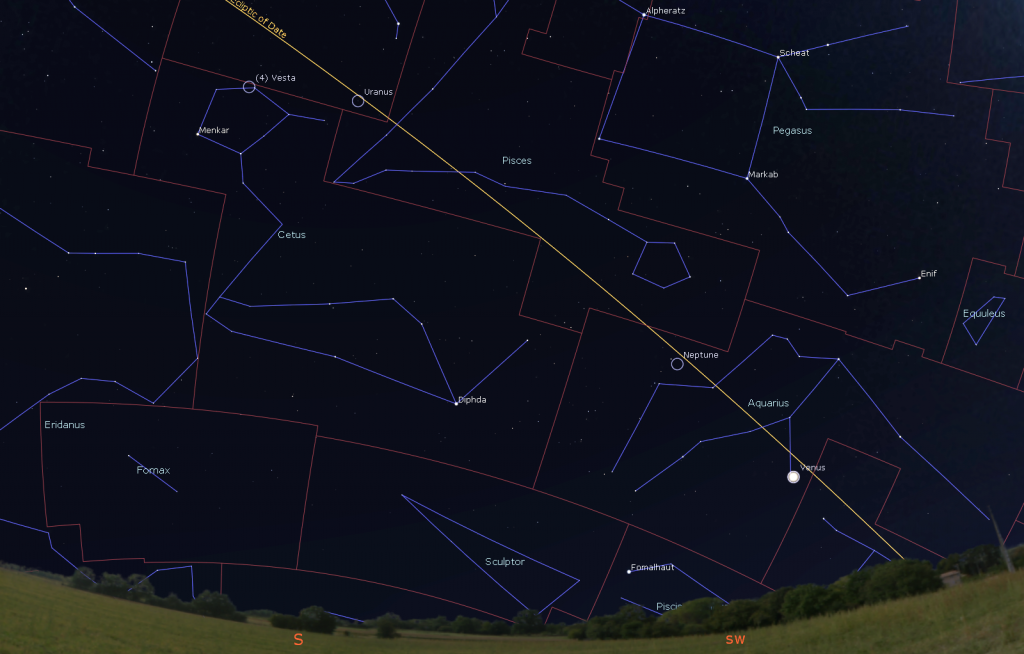
In addition to easy-to-see Venus, the harder-to-see ice giant planets Uranus and Neptune are available, too. But despite their relatively dim magnitudes and small disk sizes, the delightful colours of those two remote planets make them worthy of a look in backyard telescopes.
This week, distant and dim, blue Neptune will be lost from view well before it sets at about 10:20 pm local time. You should try to observe its tiny blue dot as soon as the sky is dark, when the planet is higher – a bit less than a third of the way up the southwestern sky. Slow-moving Neptune is among the stars of eastern Aquarius (the Water-Bearer), and is positioned less than a finger’s width to the lower right (or 1 degree to the celestial west) of a medium-bright star named Phi (φ) Aquarii. That star, which can be spotted with unaided eyes and binoculars, can guide you to Neptune. I posted a detailed finder chart here.
Both blue Neptune and that golden-coloured star will appear together in the field of view of a backyard telescope at low power. Find Phi Aquarii first and then locate nearby Neptune. Remember that binoculars will display the true relative positions of the objects, but a telescope will flip and/or mirror-image the view. (To find out what your telescope does to the image, see how it changes the view of the moon, and make a note of the result.) Venus is heading for a close rendezvous with Neptune in two weeks. That meeting will definitely let you easily find and see Neptune. Stay tuned!
Blue-green Uranus is observable from dusk until just after midnight (it sets at 1:30 am local time). It is located a generous palm’s width above (or 7° to the celestial east of) the modest stars that form the V-shaped constellation of Pisces (the Fishes). Uranus is actually located within the boundary of Aries (the Ram) – positioned below (or to the celestial south of) that constellation’s brightest stars, Sheratan and Hamal. The planet is also a fist’s diameter to the upper right of the ring of stars that form the head of Cetus (the Sea-Monster).
Shining at magnitude 5.7, Uranus’ tiny dot is bright enough to see under dark sky conditions with unaided eyes and with binoculars – or through small telescopes under less-dark conditions. To help you find it, I posted a detailed star chart here. If you view Uranus at about 6:30 pm local time, it will be highest in the southern sky – and you’ll be looking through the least amount of Earth’s disturbing atmosphere.
Don’t forget to seek out the asteroid Vesta located near Cetus’ head, too!
Treats in Taurus
January evenings feature a group of bright and distinctive constellations that are easy to recognize with unaided eyes, and which make winter nights in the Northern Hemisphere worth waiting for. They are Taurus (the Bull), Orion (the Hunter), Auriga (the Charioteer), and Gemini (the Twins). Because the evening skies will be nice and dark this week and next, I’ll guide you through the best sights to see in Taurus. In future Skylights, we’ll tour the other three constellations.
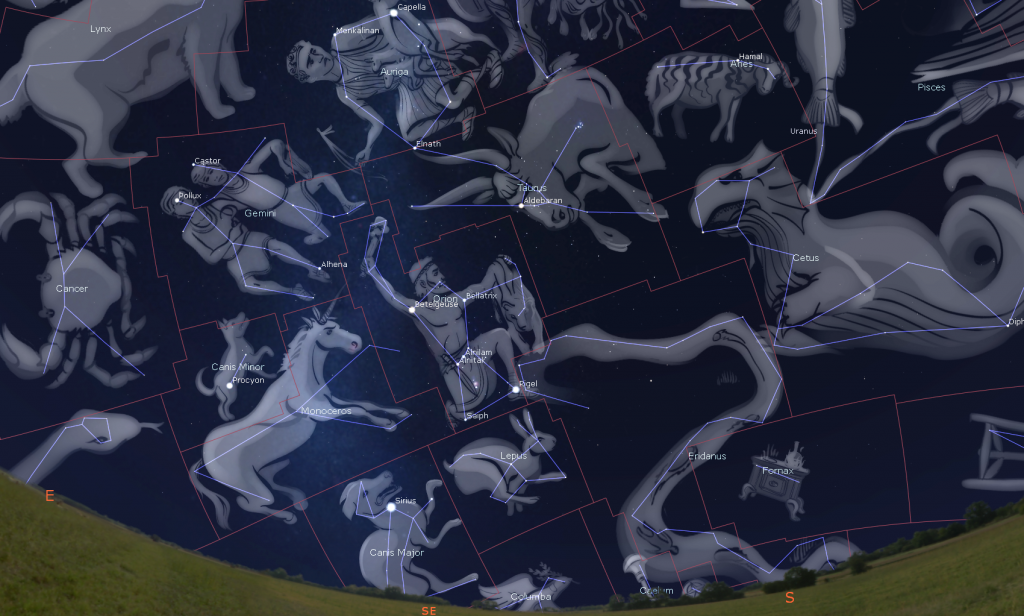
The distinctive constellation of Taurus (the Bull) is perfectly placed for evening exploration in January. It is already halfway up the eastern sky when darkness falls and it crosses the sky for almost the entire night. Taurus contains many wonderful objects to observe in binoculars, and in small or large telescopes – from spectacular star clusters to a supernova remnant, and more. Let’s talk about some of its treats you’ll spy during a winter stroll, and others that make setting up your telescope on a cold winter evening worth your while.
The constellation of Taurus is located on the ecliptic, just north of the celestial equator, making it visible almost globally. With the dim constellations of Cetus (the Whale), Aries (the Ram), and Aquarius (the Water-Bearer) lying just to the west of it (on the right), Taurus’ much brighter stars make quite an improvement on them. Taurus also borders on Orion (the Hunter), Auriga (the Charioteer), and Gemini (the Twins). Being on Taurus’ left-hand (eastern) side, they rise later in the evening. To the north sits Perseus (the Hero), and to Taurus’ lower right (or celestial southwest) is the dim and winding constellation of Eridanus (the River).
Taurus is dominated by several elements that combine to make the bull. A large triangular arrangement of stars form the bull’s face. A bright, reddish star named Aldebaran sits at the southeastern (lower left) vertex of the triangle, marking his baleful eye. He’s literally seeing red! Two bright stars sitting 1.5 fist diameters to the lower left (east) of his face mark the tips of his horns. Well above the face, the Pleiades cluster marks his hunched shoulders – and to the southwest, a handful of less prominent stars form his chest and forelegs. The rest of him is missing. When Taurus rises in the east, he is tilted sideways, with his horns down and legs extended – as if he’s charging the twins of Gemini. He doesn’t tilt upright until he enters the western half of the sky in late evening.
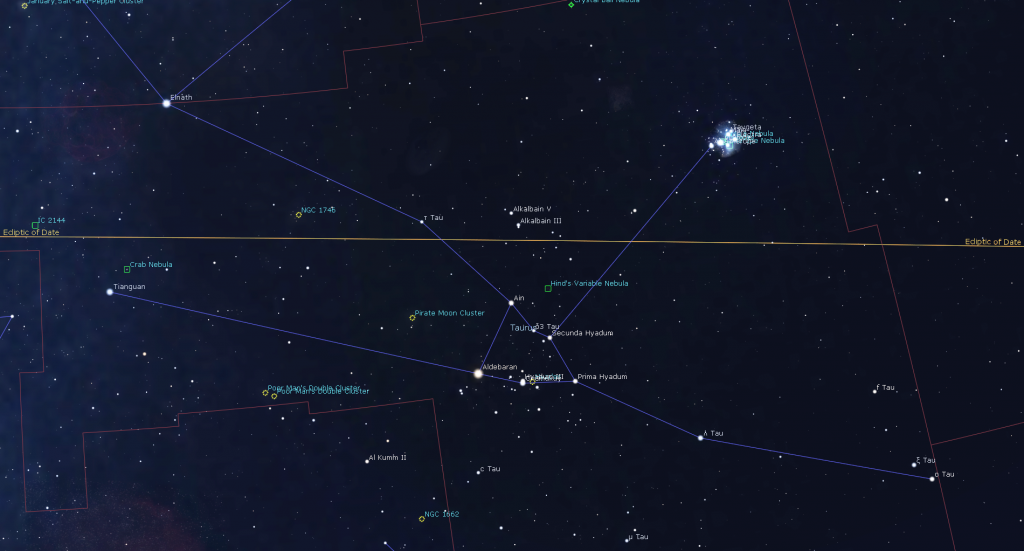
This week, Taurus will rise in mid-afternoon local time, climb high into the southern sky around 9:30 pm, and then descend westward to set around 4:30 am local time. After dusk, you can find him by continuing the line formed by Orion’s belt westwards (upwards in early evening, or to the right later on) by about two outstretched fist diameters (or 20°) until you reach bright Aldebaran. If Orion hasn’t risen yet, you can look high in the east for the little cluster of blue stars of the Pleiades and find Taurus about a fist’s diameter below them (or 12° to the celestial southeast).
Taurus’ triangular face is actually one of the nearest open star clusters to us. Located only about 150 light years away from the sun, it’s called The Hyades – named for the five daughters of Atlas in Greek mythology. It actually contains several hundred stars, with a half-dozen or so readily seen under moonless, suburban skies. It’s a lovely target to view in binoculars. Many of its stars are close pairs that astronomers call double stars. By the way, Aldebaran is not part of the cluster. It is less than half as far away!
The beautiful star cluster known as The Pleiades, or the Seven Sisters, which sits about one and a half fist widths above the bull’s face, is one of my favorite wintertime objects. It’s also designated Messier 45 (or M45), part of Charles Messier’s famous list of comet-like objects. The Pleiades is made up of the young, hot blue stars named Asterope (“A-STER-oh-pee”), Merope, Electra, Maia, Taygeta, Celaeno, and Alcyone. And those stars are indeed related – born of the same primordial gas cloud. In Greek mythology, they were the daughters of Atlas, and half-sisters of the Hyades. Only six of the sister stars are usually seen with unaided eyes – their parent stars Atlas and Pleione are huddled together at the east end of the grouping.
The Pleiades cluster is located about 450 light years away from the sun, and it, too makes a wonderful target in binoculars or a telescope at low magnification, where many more siblings are revealed! A large telescope under dark skies will also reveal blue nebulosity around the stars – reflected light from unrelated gas and dust that the stars are passing through. Galileo was among the first to observe the cluster in a telescope. In 1610, he published a sketch made at the eyepiece.
Not surprisingly, many cultures, including Aztec, Maori, Sioux, Hindu, and more, have noted this object and developed stories around it. Many indigenous groups saw the Pleiades as the doorway in to the afterlife, or the portal through which humans first fell to Earth – naming it the Hole in the Sky. In Japan, it is called Suburu, and forms the logo of the eponymous car maker. Due to its similar shape and diminutive size, some people mistake the Pleiades for the Little Dipper.
The supernova remnant called the Crab Nebula (or Messier 1) sits a finger’s width above the bull’s lower horn star, Zeta Tauri or Tianguan. You need a very large telescope to see the remnant as a dim, fuzzy patch – but on July 4, 1054 AD Chinese astronomers recorded that the star that exploded to create the Crab Nebula shone bright enough to see it in the daytime for three weeks! Then it faded to become the brightest night time star for a few months. The object is about 6,500 light-years from the sun. (Recently, astronomers have noted that Orion’s old red giant star Betelgeuse has dramatically dimmed in brightness – possibly a prelude to its own supernova explosion.)

Here’s one more treat. A very red, magnitude 4.3 star named The Ruby Star (or 119 Tauri) sits 2.7 finger widths to the right of Tianguan. It’s a variable star that pulsates every 165 days. There are even more sights to see in Taurus. You should be able to find it easily in binoculars.
The outer rim of the Milky Way passes just beyond the horn tips, and that area will reward scanning with binoculars or telescope, too.
Binocular Comet Update
A relatively modest comet is traversing the northeastern evening sky this winter – and this week will be ideal for hunting it! Designated C/2017 T2 (PanSTARRS), the comet is currently shining at magnitude 8.4. That means that it is conveniently positioned for evening viewing in good binoculars or a backyard telescope.
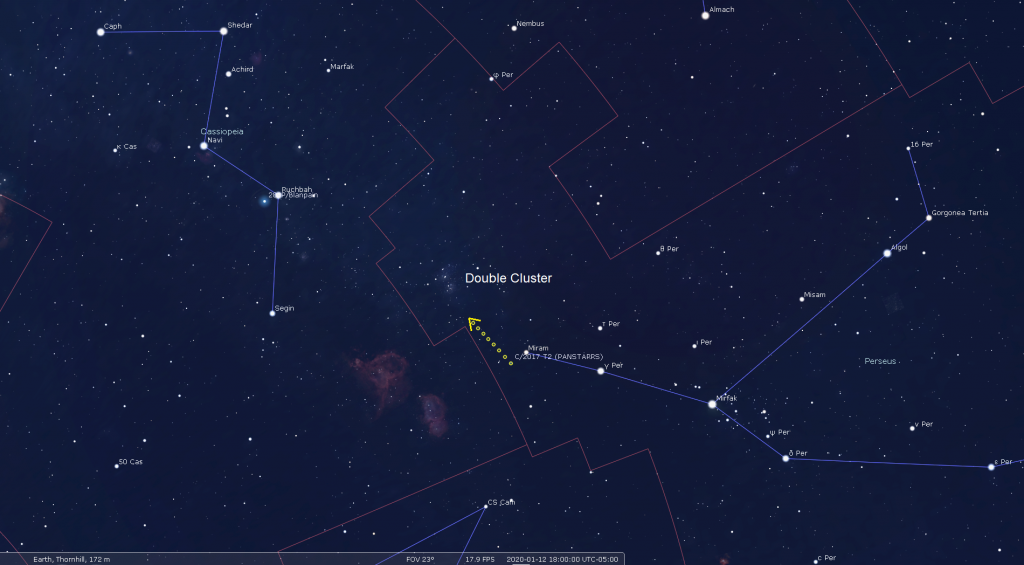
The comet is two-thirds of the way up the northeastern sky after dusk – and it moves even higher in mid-evening as the Earth’s rotation carries the sky east to west. Comets move across the background stars faster than planets wander. This week, the comet will be just inside the northern boundary of Perseus (the Hero). If you face northeast, it will be positioned a generous palm’s width to the left (or 8 degrees to the celestial north) of Mirfak, Perseus’ brightest star. Over the next seven nights the comet will move a distance of two finger widths of sky, past the famous Double Cluster and the W-shaped constellation of Cassiopeia (the Queen).
Viewed in binoculars and telescopes, Comet PanSTARRS will appear as a dim, fuzzy patch that might exhibit a faint greenish centre. It’s a bit early to see a tail, but the comet is expected to brighten much more in the coming months. Stay tuned for updates!
Public Astro-Themed Events
Every Monday evening, York University’s Allan I. Carswell Observatory runs an online star party – broadcasting views from four telescopes/cameras, answering viewer questions, and taking requests! Details are here. On Wednesday nights they offer free public viewing through their rooftop telescopes, including their brand new 1-metre telescope! If it’s cloudy, the astronomers give tours and presentations. Registration and details are here.
At 7:30 pm on Wednesday, January 15, the RASC Toronto Centre will hold their free monthly Speaker’s Night Meeting at the Ontario Science Centre, and the public are welcome. This month, the speaker will be the terrific speaker Professor Paul Delaney, Senior Lecturer, Allan I. Carswell Chair for the Public Understanding of Astronomy at York University. His topic will be Exoplanets. Check here for details. Parking is free.
This winter, spend a Sunday afternoon in the other dome at the David Dunlap Observatory! On Sunday, February 9, from noon to 4 pm, join me in my Starlab Digital Planetarium for an interactive journey through the Universe at DDO. We’ll tour the night sky and see close-up views of galaxies, nebulas, and star clusters, view our Solar System’s planets and alien exo-planets, land on the moon, Mars – and the Sun, travel home to Earth from the edge of the Universe, hear indigenous starlore, and watch immersive fulldome movies! Ask me your burning questions, and see the answers in a planetarium setting – or sit back and soak it all in. Sessions run continuously between noon and 2 pm, and repeat from 2 to 4 pm. Ticket-holders may arrive any time during the program. The program is suitable for ages 3 and older. The Starlab planetarium is wheelchair accessible, but everyone else sits at floor level. For tickets, please use this link. Tickets for future dates will be available soon.
Keep looking up, and enjoy the sky when you do. I love questions and requests – so, send me some!